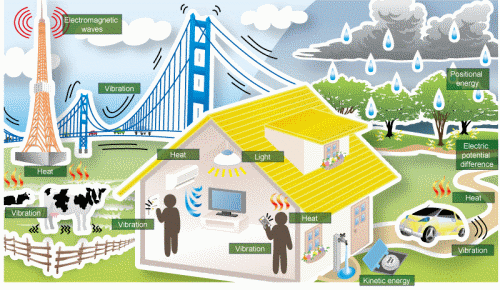Energy harvesting is the process by which ambient energy is captured and converted into electricity for small autonomous devices, such as satellites, laptops and nodes in sensor networks making them self-sufficient. Although energy harvesting applications reach from vehicles to the smart grid, the majority of the value this year is in consumer electronic applications, where energy harvesters have been used for some time.

Energy harvesting includes photovoltaics, thermovoltaics, piezoelectrics and electrodynamics, among other options. The technology has reached a tipping point, because the necessary lower power electronics and more efficient energy gathering and storage are now sufficiently affordable, reliable and longer lived for a huge number of applications to be practicable. From wind-up laptops for Africa, wireless light switches working from the power of your finger and wireless sensors in oil fields monitoring equipment power by vibration – these are all in use now with many more applications emerging.
The report covers a wide array of applications including: wristwatches bicycle dynamos, laptops, e-books mobile phones, calculators, toys, piezo gas lighters, electronic car keys, electronic apparel, wireless sensor mesh networks, buildings, machinery, engines, non-meshed wireless sensors and actuators, military and aerospace needs, healthcare implants, disposable testers and drug delivery, and even animals, and farming.
Energy harvesting by technology type
This year, most of the harvesters used in the above market segments are solar cells followed by electrodynamos, two relatively mature energy harvesting technologies. However, many new technologies are now taking some market share enabling power in areas not possible before. This includes thermoelectrics – generating power from heat – where organisations such as the Department of Energy in the US are working with BMW and GM to turn heat waste from engines and exhaust into power for the vehicle's electrical systems. NASA uses thermoelectrics to power Mars rovers where they work without light, unlike solar cells. Piezoelectric energy harvesters are also of great interest due to their small form factor and high efficiency. In 2022, these four energy harvester types will have near similar market share for industrial sensing applications. However, even by then solar will continue to dominate for consumer applications. For the first time, this unique report looks at the global situation. It covers the progress of more than 350 organizations in 22 countries and gives detailed case studies. Market forecasts are provided for everything from self-sufficient wristwatches to mobile phones that will never need a charger and light switches and controls that have no wiring and no batteries when fitted in buildings to wireless sensors power from the environment they are placed in. However, there are further mountains to climb in order to achieve self-powered wireless sensors monitoring forest fires, pollution spillages and even inside the human body and in the concrete of buildings. These applications will become commonplace one day. Even devices with maintenance-free life of hundreds of years can now be envisaged. Meanwhile, bionic man containing maintenance free, self-powered devices for his lifetime is an objective for the next few years. IDTechEx find that the total market for energy harvesting devices, including everything from wristwatches to wireless sensors will rise to over $2.6 billion in 2024.
How do these things work? Which technologies have the most potential now and in the future? What are the advantages and disadvantages of each? Which countries have the most active programs and why? What are the leading universities, developers, manufacturers and other players up to? What alliances exist? What are the timelines for success? All these questions and more are answered in this report. Analyst access from IDTechEx All report purchases include up to 30 minutes telephone time with an expert analyst who will help you link key findings in the report to the business issues you're addressing. This needs to be used within three months of purchasing the report. Further information or call Raoul at 617 577 7890
Advertisement





